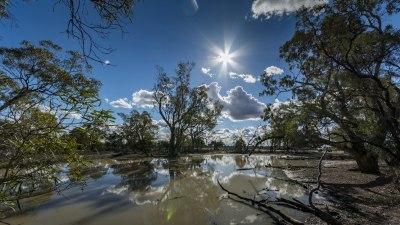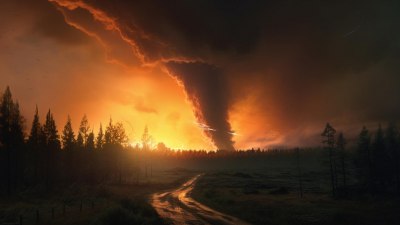How to Spot the One Warm Patch in a Freezing River (And Whether You Want To)
Learn how to identify warm patches in freezing rivers and the safety measures to consider.

This image was created with the assistance of Freepik
Exploring the great outdoors during winter can be both exhilarating and dangerous. One of the most intriguing yet potentially hazardous experiences is spotting the warm patches in freezing rivers. Whether you're an adventurer, a scientist, or simply a curious onlooker, understanding how to identify these warm spots and knowing whether to approach them is essential. In this article, we'll delve into the mechanics of freezing rivers, the significance of warm patches, and the precautions one should take in such situations.
The Mechanics of Freezing Rivers
Rivers freeze due to a combination of air temperature, water movement, and surrounding environmental conditions. When temperatures drop, particularly in winter months, the top layer of the river can begin to freeze, creating an icy surface. However, several factors can result in the formation of warmer patches within the river, leading to some areas remaining unfrozen.
Understanding Warm Patches
Warm patches in freezing rivers are areas where the water remains liquid despite the overarching cold conditions. These patches can occur due to various factors, such as water currents, geothermal activity, or the presence of aquatic life. Below, we will explore these contributing factors.
1. Water Currents
One of the most common reasons for the existence of warm patches is the flow of water beneath the icy surface. Where the water flows rapidly, it holds less time in contact with the cold air, preventing ice from forming. This phenomenon can create pockets of liquid water amidst a frozen landscape, making these areas crucial for wildlife.
2. Geothermal Activity
In certain regions, geothermal activity may influence river temperatures and create warm patches. This activity can arise from thermal springs or volcanic activities nearby, significantly warming the water in specific locations. These areas might be fewer in number, but they are notably important ecological spots.
3. Aquatic Life
Another factor influencing water temperature is the presence of aquatic organisms. The metabolic processes of fish and other creatures can slightly raise the temperature of nearby water. This means that areas with abundant aquatic life might also exhibit warmer temperatures, providing a necessary habitat during cold months.
Where to Look for Warm Patches
Now that we understand what warm patches are, where can you spot them? When scouting for these areas in a freezing river, here are a few tips:
1. Observe Current Flow
Start by looking for areas with faster water movement. You can usually identify these spots by observing ripples or continuous flow. Fast-moving water often resists freezing and will be colder than surrounding areas, as it doesn't allow ice to form easily.
2. Check for Underwater Structures
Check for underwater structures such as rocks, bridges, or fallen trees. These can disrupt the flow of water and create unique conditions that may result in warm patches nearby. If a structure diverts or accelerates the flow, it can create a localized warming effect.
3. Look for Wildlife Activity
If you see areas where birds are congregating or where fish are jumping, these may be indicators of warmer patches. Wildlife often seeks out warmer water for survival, making it easier for you to spot areas where the water remains liquid.
4. Evaluate Surrounding Vegetation
Sometimes, vegetation can give you clues about warm patches. For instance, look for areas where the grasses or reeds appear healthier and more vibrant. If there's less frost or ice on the plants higher up along the banks, it may suggest the presence of warmer water nearby.
Safety Considerations
While the allure of warm patches can be enticing, it’s vital to prioritize safety when approaching these areas. Below are crucial safety considerations:
1. Assess Ice Thickness
Before venturing out, evaluate the ice thickness. If you’re considering standing or walking on the ice, ensure that it has a minimum thickness guideline of at least four inches. Always be cautious, as ice can be unpredictable.
2. Stay Aware of Current
Be aware of the strength of the river's current. Fast-moving water can be deceptively dangerous, so keep your distance from areas where the current appears strong. It's best to observe warm patches from a safe distance.
3. Avoid Leaning Over Ice
When near a river's edge, avoid leaning over or putting excessive weight on the ice to peek into the warm patches. The ice can crack, and falling into freezing water is dangerous and can lead to hypothermia or drowning.
4. Dress Appropriately
Wear proper winter gear. Layering your clothing will help retain heat and keep you dry. Waterproof boots with good traction can help if you need to navigate around icy areas.
5. Have a Buddy System
Whenever possible, don’t go alone. Having another person with you increases your safety and provides assistance if an emergency arises. Make sure to inform someone of your plan and approximate return time.
Real-life Experiences
Spotting warm patches in freezing rivers has fascinated many. From scientists studying aquatic ecosystems to adventurers savoring the beauty of nature, the thrill of discovering these unique phenomena has led many to share their experiences. One such account comes from a wildlife researcher working in a northern habitat, where she documented the impact of these thermal patches on fish breeding patterns during winter.
In summary, spotting warm patches in freezing rivers is not only an adventure but also an exploration of nature’s wonders. Understanding the mechanics behind these phenomena enhances our knowledge of aquatic ecosystems while urging the need for safety measures. Remember to observe and appreciate from a safe distance, ensuring that your adventures in the chilly wilderness remain enjoyable and secure.











